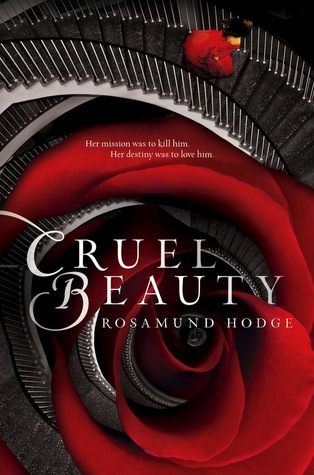
I’m always on the hunt for great fiction, and when I find strong female characters in wonderful books it’s a double bonus. Three books I read recently featured strong women in unusual ways. The first was Cruel Beauty, a retelling of Beauty and the Beast, by Rosamund Hodge. Nyx, the main character, is promised to Ignifex, The Gentle Lord, her entire life. She has also trained to kill him and free her kingdom.
Both Nyx and Ignifex enthralled me right away, as well as the setting. Most of the action takes place within the Gentle Lord’s palace, a magically shifting panorama of rooms and landscapes. Nyx is free to explore except for some locked rooms, and of course she immediately goes for those forbidden places. I adored her inquisitive nature, and the blossoming, forbidden romance between her and her husband is breathtaking. As well, the –punk nature of the book (I suppose you could call it Thaumaturgy or Elemental Punk) grabbed me and kept me enthralled. Without access to the sun, Nyx’s kingdom relies on old magicks for energy, and the way Hodge built their world as well as Ignifex’s palace was incredible.
Buy Cruel Beauty at Amazon
Cruel Beauty started a hunt for more strong females in fiction, and I found several Indies doing just that. There are a few things I must have if the book is published by the author or a small publisher: the editing must be meticulous, the story planned and developed, and the characters vibrant. Kindar’s Cure and Huw the Bard fulfilled my requirements and served up wonderful stories as well.
 I took a look at the sample of Kindar’s Cure, a lovely book by Michelle Hauck, and several things lured me right in: the princess (Kindar) suffers from a congenital disease called the Choke Lung. That made her stand out right away from the plethora of princesses in fantasy and medieval fiction.
I took a look at the sample of Kindar’s Cure, a lovely book by Michelle Hauck, and several things lured me right in: the princess (Kindar) suffers from a congenital disease called the Choke Lung. That made her stand out right away from the plethora of princesses in fantasy and medieval fiction.
Second, in Kindar’s Cure the ruling class is a matriarchy. Furthermore, the women rulers own a harem of males called ‘amores’ – Kindar has her own special amore who becomes central to the story. A heroine who wasn’t put up in an ivory tower to marinate in her own purity intrigued me. Plus, the concept of the amores wasn’t there for mere salacious purposes or smut for smut’s sake; there was a reason for that portion of the storyline.
Kindar’s Cure was extremely interesting, turning back on itself in quite a few hairpin curves. I was taken in by one character and appalled by another – in other words, I had a personal reaction to the plot arcs. That shows the story telling was successful.
I do feel there could have been a bit more editing for Cure. Sentence structure was, at times, too repetitive and choppy. I pinpointed several paragraphs that could have benefited from a skillful red pen to really make the voice sing. As well, there was a section of head hopping in the final chapters so abrupt it made my mind whirl. However, neither of these caveats is really serious; in fact I’m being a nit-picking editor to mention them at all. In the end, I would give Kindar’s Cure a solid four stars with an added half star for the strong, feminine characters.
Buy Kindar's Cure at Amazon
 Huw the Bard is also medieval fantasy with a well-drawn background. Both Jasperson, the author of Huw, and Hauck are confident world-builders who considered history, politics, and current conflicts as they wrote their novels.
Huw the Bard is also medieval fantasy with a well-drawn background. Both Jasperson, the author of Huw, and Hauck are confident world-builders who considered history, politics, and current conflicts as they wrote their novels.
Another similarity between the two books was the strong women characters. In Huw, many of the females insist on having control of their own destinies. Only one character is overshadowed by a tyrant husband, but she rebels against him with Huw’s help. The other women all take lovers as they wish and refuse to be tied to marriage at a father’s or brother’s convenience.
As for Huw, I have to admit I have a bit of a crush on him. He is a harpist with hair down to his waist who is forced out of his lazy, sensual existence into a series of harrowing adventures on the road. Against a background of tyranny after a ruler burns an entire Guild Hall filled with bards to the ground, Huw must find his way in order to save his family, friends – as well as his entire craft.
Jasperson’s book is bawdy but not overly so, and the relations between the characters are always tender if not lasting. I would rate Kindar’s Cure at a T for Teen (although it would be better for readers 16+) and Huw the Bard at M for violence and erotic scenes.
Buy Huw the Bard at Amazon
Alison DeLuca is the author of several steampunk and urban fantasy books. She was born in Arizona and has also lived in Pennsylvania, Illinois, Mexico, Ireland, and Spain. Currently she wrestles words and laundry in New Jersey. Connect with Alison on Facebook, Twitter, Google+, Pinterest, and her blog.
Girl Who Reads is an Amazon advertising affiliate; a small fee is earned when purchases are made at Amazon through the above links.




















0 comments:
Post a Comment